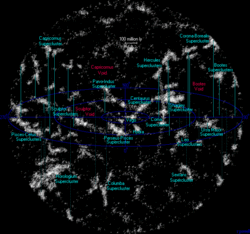- Void (astronomy)
-
In astronomy, voids are the empty spaces between filaments, the largest-scale structures in the Universe, that contain very few, or no, galaxies. They were first discovered in 1978 during a pioneering study by Stephen Gregory and Laird A. Thompson at the Kitt Peak National Observatory.[1] Voids typically have a diameter of 11 to 150 megaparsecs; particularly large voids, defined by the absence of rich superclusters, are sometimes called "supervoids". Voids located in high-density environments are smaller than voids situated in low-density spaces of the universe.[2]
Voids were formed by baryon acoustic oscillations in the Big Bang by collapses of mass followed by implosions of the compressed baryonic matter. The shells of the voids are the remnants of shock fronts left by this process. The decoupling of matter from radiation when the universe became transparent "froze" the voids and shock fronts in place.[citation needed]
See also
- List of voids
- List of superclusters
- Large-scale structure of the universe
References
- ^ Freedman, R.A., & Kaufmann III, W.J. (2008). Stars and galaxies: Universe. New York City: W.H. Freeman and Company.
- ^ U. Lindner, J. Einasto, M. Einasto, W. Freudling, K. Fricke, E. Tago (1995). The Structure of Supervoids I: Void Hierarchy in the Northern Local Supervoid "The structure of supervoids. I. Void hierarchy in the Northern Local Supervoid". Astron. Astrophys. 301: 329. arXiv:astro-ph/9503044. Bibcode 1995A&A...301..329L. http://www.uni-sw.gwdg.de/research/preprints/1995/pr1995_14.html/ The Structure of Supervoids I: Void Hierarchy in the Northern Local Supervoid.
External links
- Universe family tree: Void
- Animated views of voids and their distribution from Hume Feldman with Sergei Shandarin, Dept. Physics and Astronomy, University of Kansas, Lawrence, KS, USA.
- Visualization of Nearby Large-Scale Structures Fairall, A. P., Paverd, W. R., & Ashley, R. P.
Galaxy Morphology - Elliptical galaxy
- Lenticular galaxy
- (unbarred
- barred)
- Spiral galaxy
- ([barred
- intermediate
- unbarred]
- [grand design
- flocculent
- Magellanic spiral])
- Irregular galaxy
- Dwarf galaxy
- Dwarf elliptical
- Dwarf spheroidal
- Dwarf spiral)
- Giant galaxy
- (Giant elliptical
- D-galaxy
- cD-galaxy)
Structure Active nuclei Energetic galaxies - Starburst galaxy
- (Wolf–Rayet
- BCD
- pea)
- LIRG
- (ULIRG
- HLIRG)
- LAE
Interaction - Stellar stream
- Interacting galaxy
- Satellite galaxy
- Groups and clusters
- (fossil group
- brightest cluster galaxy)
- Superclusters
- Walls
- Field galaxy
- Void galaxy
- Voids and supervoids
Lists See also - Dark galaxy
- Intergalactic dust
- Intergalactic travel
- Intergalactic stars
 Book:Galaxies
Book:Galaxies Category:Galaxies
Category:Galaxies Portal:Astronomy
Portal:Astronomy
Categories:
Wikimedia Foundation. 2010.


